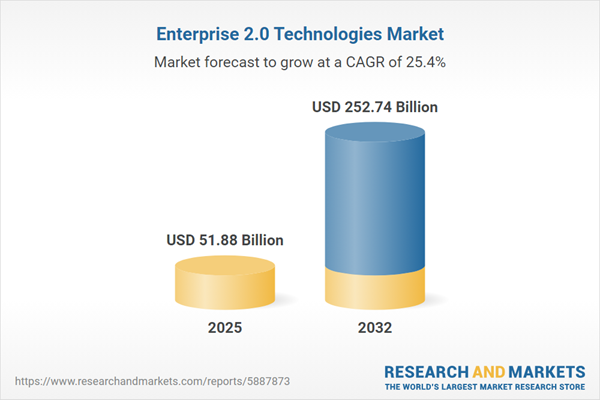Speak directly to the analyst to clarify any post sales queries you may have.
Enterprise 2.0 technologies are reshaping how organizations approach internal collaboration, operational agility, and digital transformation initiatives. Senior decision-makers benefit from targeted insights to align enterprise priorities, modernize processes, and position their companies to adapt to fast-changing business environments.
Market Snapshot: Enterprise 2.0 Technologies Market
The Enterprise 2.0 Technologies Market is witnessing strong global momentum, driven by the surge in digital transformation investment across all sectors. In 2024, the market reached USD 41.26 billion and is projected to rise to USD 51.88 billion in 2025. With a compound annual growth rate (CAGR) of 25.42%, the industry is anticipated to exceed USD 252.74 billion by 2032. This expansion underscores the pressing need for organizations to advance digital strategies, enhance operational efficiency, and build connected teams—especially as regulatory shifts and evolving business models challenge long-standing technology practices.
Scope & Segmentation of the Enterprise 2.0 Technologies Market
A clear understanding of the scope and segmentation of the Enterprise 2.0 Technologies Market empowers executives to make informed platform, process, and investment decisions. The market’s segmentation reflects the distinct operational requirements, regional dynamics, and growth objectives that shape enterprise adoption paths.
- Application: Encompasses analytics platforms, business process management, and social collaboration tools that support greater visibility, organizational alignment, and agile decision-making for diverse leadership teams.
- Deployment Mode: Includes cloud, hybrid, and on-premises models, enabling organizations to tailor deployments based on security demands, compliance requirements, and scalability needs.
- Organization Size: Solutions are designed to support both small businesses and large enterprises, allowing flexible technology adoption throughout various digital transformation phases.
- Industry Vertical: Covers sectors such as banking, insurance, government, healthcare, education, IT, telecom, manufacturing, and retail, addressing their specific operational challenges, compliance expectations, and digital maturity objectives.
- Payment Model: Offers subscription-based, freemium, and perpetual licensing options, giving companies the flexibility to align technology investments with budget planning and risk considerations.
- Geographical Coverage: Adoption trends differ across the Americas, Europe, Middle East and Africa, and Asia-Pacific, with factors such as regulatory environments and infrastructure readiness shaping the pace and scale of implementation.
- Company Analysis: Leading providers—including Microsoft, Salesforce, IBM, Oracle, Alphabet, Cisco, Atlassian, SAP, HCL Technologies, and OpenText—play a crucial role in defining competitive differentiation and steering market innovation.
Key Takeaways for Senior Decision-Makers
- Cloud and hybrid models accommodate changing enterprise requirements, supporting seamless integration between legacy infrastructure and innovative technologies.
- Advanced analytics and collaborative platforms enhance responsiveness and data-driven outcomes, enabling organizations to remain resilient during market shifts and technology disruption.
- Mobile-first approaches facilitate continuous team productivity and connectivity, essential for geographically distributed workforces navigating diverse market dynamics.
- Centralized compliance and communications structures reduce operational risk, improve auditability, and reinforce oversight across the enterprise.
- Tailored implementations for regulated industries help adapt to evolving policy landscapes and streamline compliance as standards change.
- Flexible payment options allow adoption in stages, enabling leaders to prioritize technology investments that best serve current capabilities and future business growth.
Tariff Impact: Navigating 2025 Regulatory Shifts
Recent US tariffs on hardware and software have prompted organizations to reassess vendor partnerships and diversify supply chains. Proactive actions such as supplier diversification, nearshoring operations, renegotiating contractual terms, and establishing regional alliances help maintain supply continuity and support stable margins in the face of ongoing regulatory and cost fluctuations.
Methodology & Data Sources
Analysis is grounded in executive-level interviews, comprehensive reviews of vendor and financial documents, and findings from end-user surveys. Incorporating multiple data points ensures robust, actionable guidance for technology investment and adoption decisions at the senior leadership level.
Why This Report Matters: Enterprise 2.0 Technologies Market
- Enables organizations to realign digital transformation strategies in response to changing regulations and volatile global markets.
- Guides leaders in selecting the right technologies, modernizing processes, and proactively managing risk to support governance and business continuity.
- Provides benchmarks for collaboration and innovation, supporting an objective assessment of current capabilities against peers and industry standards.
Conclusion
Enterprise 2.0 technologies equip companies to align IT initiatives with business goals, strengthen collaboration, and manage ongoing digital transformation effectively, fostering resilience and ongoing organizational growth.
Additional Product Information:
- Purchase of this report includes 1 year online access with quarterly updates.
- This report can be updated on request. Please contact our Customer Experience team using the Ask a Question widget on our website.
Table of Contents
3. Executive Summary
4. Market Overview
7. Cumulative Impact of Artificial Intelligence 2025
Companies Mentioned
The companies profiled in this Enterprise 2.0 Technologies market report include:- Microsoft Corporation
- Salesforce, Inc.
- International Business Machines Corporation
- Oracle Corporation
- Alphabet Inc.
- Cisco Systems, Inc.
- Atlassian Corporation Plc
- SAP SE
- HCL Technologies Limited
- OpenText Corporation
Table Information
| Report Attribute | Details |
|---|---|
| No. of Pages | 186 |
| Published | October 2025 |
| Forecast Period | 2025 - 2032 |
| Estimated Market Value ( USD | $ 51.88 Billion |
| Forecasted Market Value ( USD | $ 252.74 Billion |
| Compound Annual Growth Rate | 25.4% |
| Regions Covered | Global |
| No. of Companies Mentioned | 11 |









